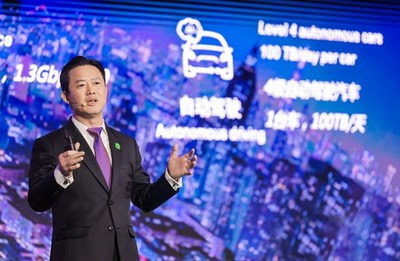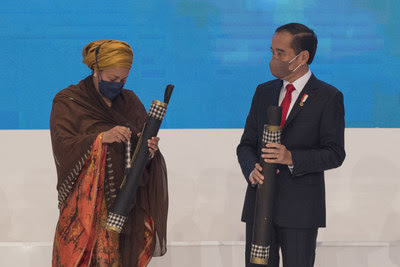DONGGUAN, Chine, 27 mai 2022 /PRNewswire/ — Huawei a révélé la définition des centres de données de nouvelle génération et a dévoilé PowerPOD 3.0, un tout nouveau système d’alimentation électrique, le 26 mai à Dongguan, en Chine. Ces nouveaux déploiements, basés sur la sagesse collective et les efforts conjoints de l’équipe des centres de données de Huawei et des experts du secteur, réaffirment l’engagement de Huawei à construire des centres de données intelligents et à faible émission de carbone.

Définition des centres de données de nouvelle génération
Charles Yang, vice-président principal de Huawei et directeur général de l’équipe des centres de données de Huawei, a présenté la définition révolutionnaire des centres de données de nouvelle génération lors de l’événement de lancement. Il a souligné que les experts techniques et les autorités du secteur sont parvenus à un consensus sur les quatre caractéristiques des centres de données de nouvelle génération après des discussions approfondies, à savoir : durabilité, simplification, conduite autonome et fiabilité.
Durabilité : Les centres de données de nouvelle génération seront entièrement écologiques et écoénergétiques, tout en maximisant le recyclage de tous les matériaux des centres de données. Ainsi, l’écosystème global du centre de données sera écologique et respectueux de l’environnement. Pour assurer la durabilité des centres de données, il convient d’utiliser des ressources vertes – électricité, terre et eau – et de maximiser le recyclage des matériaux utilisés tout au long du cycle de vie. Outre l’efficacité de l’utilisation de l’énergie (PUE), largement utilisée, d’autres indicateurs, notamment l’efficacité de l’utilisation du carbone (CUE), l’efficacité de l’utilisation de l’eau (WUE) et l’efficacité de l’utilisation du réseau (GUE), seront également utilisés pour mesurer la durabilité des centres de données.
Simplification : architecture, alimentation et refroidissement simplifiés incarnent l’évolution des centres de données.
L’architecture simplifiée crée des formes innovantes de bâtiments et de salles d’équipement. Si le mode de construction modulaire préfabriqué est utilisé pour construire un centre de données de 1000 baies, la période de construction peut être réduite de plus de 18 mois à 6-9 mois.
L’alimentation simplifiée réorganise les composants et les liaisons. Elle permet de réduire le délai de livraison de 2 mois à 2 semaines. Le refroidissement simplifié maximise l’efficacité de l’échange thermique en remplaçant plusieurs échanges thermiques par un seul, et en réduisant la liaison de refroidissement.
Conduite autonome : L’automatisation de l’exploitation et de la maintenance, l’optimisation de l’efficacité énergétique et l’autonomie d’exploitation remodèlent la gestion de l’exploitation et de la maintenance des centres de données. L’automatisation de l’exploitation et de la maintenance permet aux ingénieurs d’effectuer à distance le contrôle de 2 000 baies en 5 minutes. L’optimisation de l’efficacité énergétique permet de mettre en place une stratégie de refroidissement optimale via 1,4 million de combinaisons originales en 1 minute, ce qui permet de réaliser un refroidissement intelligent. L’autonomie d’exploitation maximise la valeur des ressources.
Fiabilité : La sécurité proactive et l’architecture sécurisée garantissent une qualité supérieure et un développement durable des centres de données. La sécurité proactive implique l’utilisation des technologies de big data et d’IA pour mettre en œuvre une maintenance prédictive, des composants aux centres de données, basée sur la visibilité et la perception de tous les domaines dans les centres de données. La réponse automatique en cas de panne signifie qu’il ne faudra qu’une minute pour repérer une panne, 3 minutes pour l’analyser et 5 minutes pour la réparer. Une architecture sécurisée signifie que la sécurité sera assurée à différents niveaux, tels que les composants, les dispositifs et les systèmes. Au niveau des systèmes, la plate-forme E2E visualisable, gérable et contrôlable permet d’atteindre une disponibilité des systèmes de 99,999 %.
PowerPOD 3.0 : Un système d’alimentation qui permet de réduire l’empreinte carbone, de gagner du temps et d’économiser de l’énergie
Lors de l’événement, Fei Zhenfu, directeur technique de l’équipe des centres de données de Huawei, a dévoilé PowerPOD 3.0, un système d’alimentation de nouvelle génération. Ce système réduit l’empreinte carbone de 40 %, la consommation d’énergie de 70 %, le délai de livraison de 2 mois à 2 semaines et le taux d’erreur dans les ENS de 38 %.

Dans la perspective de la prochaine génération de centres de données, l’innovation technologique sera un facteur clé pour assurer un développement durable. Huawei continuera à réaliser des percées en matière de produits et de technologies grâce à des investissements soutenus en R&D et à une collaboration étendue avec les clients, les partenaires de l’écosystème et les organisations du secteur. Nous pouvons ensemble inaugurer une nouvelle ère de développement des centres de données.
Photo – https://mma.prnewswire.com/

